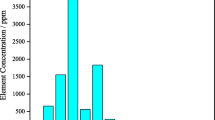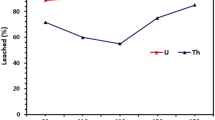Rare earth metals (REM) after sulfuric acid treatment of apatite ore are partly (15–20%) transferred into extraction phosphoric acid (EPA) solution. Solvent extraction of REM from model and industrial solutions of EPA is investigated. Di-(2-ethylhexyl)phosphoric acid (D2EHPA) diluted with kerosene is used as an extraction agent. The effect of impurity ions \( \left({\mathrm{Fe}}^{3+},{\mathrm{SO}}_4^{2\hbox{--}}\right) \) on REM extraction from industrial solutions is considered. Good separation coefficients of adjacent pairs of REM from EPA are obtained that may be used for effective separation the group of “light” from “heavy” rare earth metals from concentrated phosphoric acid solutions. Results of studies also show that an increase in the separation factor of erbium/ytterbium is possible by increasing the D2EHPA content in the organic phase. D2EHPA concentration, contact time, aqueous phase composition and the optimum conditions for the extraction of REM are determined. Using sulfuric acid concentration of 20 to 40% in the cleaning stage from iron provides additional purification from undesirable impurities. A production scheme is provided for REM separation during EPA treatment.





Similar content being viewed by others
References
E. Mosisa, V. Bazhin, and S. Savchenkov, “Review on nano particle reinforced aluminum metal matrix composites,” Research J. Appl. Sci., 11, No. 5, 188–196 (2016).
É. P. Lokshin, V. T. Kalinnikov, and O. A. Tareeva, “Rare earth element extraction from industrial products and Khibinsk apatite deposit treatment technogenic waste,” Tsvet Met., 8, No. 11, 75–79 (2012).
V. M. Sizyakov, A. A. Vlasov, and V. Yu. Bazhin, “Strategy tasks of the Russian metallurgical complex,” Tsvetnye Metally, No. 1, 32–37 (2016).
O. V. Cheremisina and V. V. Sergeev, “А review on recovery of rare earth elements from wet process phosphoric acid,” Proc. 15 th Int. Multidisciplinary Sci. GeoConf. SGEM 2015 (June 18–24, 2015).
W. Liangshi, L. Zhiqi, H. Xiaowei, et al., “Recovery of rare earths from wet-process phosphoric acid,” Hydrometallurgy, 101, 41–47 (2010).
S. Radhika, K. B. Nagaphani, M. L. Kantam, and B. R. Reddy, “Liquid–liquid extraction and separation possibilities of heavy and light rare-earths from phosphoric acid solutions with acidic organophosphorus reagents,” Separation and Purification Technology, 75, No. 3, 295–302 (2010).
S. Radhika, K. B. Nagaphani, M. L. Kantam, and B. R. Reddy, “Solvent extraction and separation of rare-earths from phosphoric acid solutions with TOPS 99,” Hydrometallurgy, 110, 50–55 (2011).
D. E. Chirkst, I. A. Dibrov, O. V. Cheremisina, and I. V. Melikhov, “Solubility of phosphate of cerium (III) in phosphoric acid,” Magazine of Physical Chemistry, 65, No. 8, 2180–2183 (1991).
K. B. Yatsimirskii, N. A. Kostromina, Z. A. Sheka, et al., Complex Rare Earth Chemical Compounds [in Russian], Naukova Dumka, Kiev (1966).
Author information
Authors and Affiliations
Corresponding author
Additional information
Translated from Metallurg, Vol. 63, No. 3, pp. 71–76, March, 2019.
Rights and permissions
About this article
Cite this article
Cheremisina, O.V., Sergeev, V.V., Fedorov, A.T. et al. Rare Earth Metal Extraction from Apatite Ores. Metallurgist 63, 300–307 (2019). https://doi.org/10.1007/s11015-019-00824-9
Received:
Published:
Issue Date:
DOI: https://doi.org/10.1007/s11015-019-00824-9




